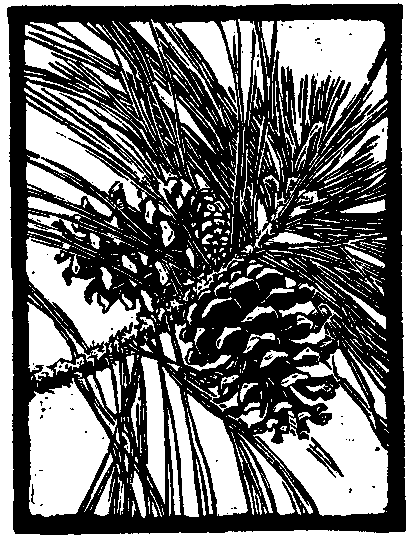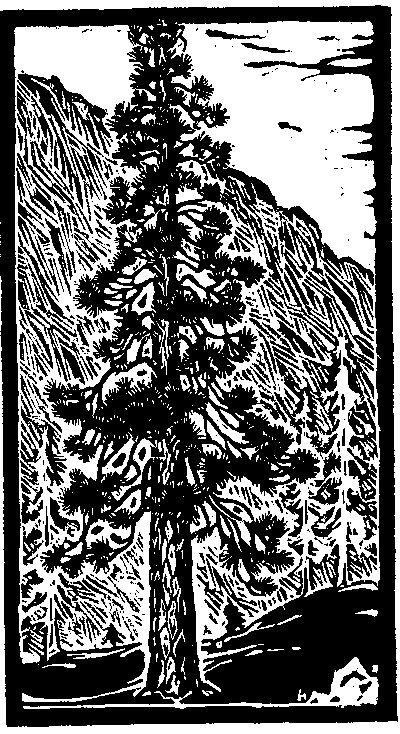
Ponderosa Pine Cones
Slightly Less Than 1/2 Natural Size
| Online Library: | Title | Author | California | Geology | History | Indians | Muir | Mountaineering | Nature | Management |
Yosemite > Library > Trees > Ponderosa Pine >
Next: Jeffrey Pine • Contents • Previous: White-Bark Pine
Pinus ponderosa Dougl.

Ponderosa Pine Cones Slightly Less Than 1/2 Natural Size |

Ponderosa Pine Tree |
The Ponderosa (or Western Yellow) Pine is the commonest conifer on the floor of the Yosemite Valley. Dense stands of young trees with their blackish, roughened trunks border the meadows; in more open places, the splendid clear shafts of the mature pines stand boldly forth along the river or on the gradual slopes below the talus, for example, near the foot of the Four-Mile Trail to Glacier Point. The thick bark of these older trees is tawny, with deep fissures dividing the surface into plates made up of small, irregularly shaped scales which provide an endless supply of Noah’s Ark animals for children at play.
The needles are yellowish-green, three in a bundle, varying from five to eleven inches in length. The cones mature in August of the second year and vary from two and a half to five and a half inches in length. When the cone falls, some of the scales are usually left on the branch.
The Ponderosa Pine, under favorable conditions, attains a height of one hundred and twenty-five to one hundred and seventy-five feet; its diameter is often four to six feet and sometimes as much as ten or twelve feet. Jepson says that when Douglas described it on the Spokane River he named it ponderosa because of its great size.
Unlike most pines, this tree has a very wide distribution —dry ridges, moist valley bottoms, gravelly slopes. According to Jepson, it is “subject to greater Variations of temperature and precipitation than any other North American tree.” It is associated with California Black Oak and Incense Cedar at its lower ranges, and with White Fir and Sugar Pine at its upper limits.
The giant Ponderosa Pine near the foot of Sentinel Rock is an unusually fine specimen. It dominates the forest about it, dwarfing by comparison what would ordinarily be considered a goodly member of the same family. Mr. Charles Michaels estimates, from comparison with Ponderosa Pines of known age, that this must be in the neighborhood of five hundred years old, and that for its first three hundred years it probably stood alone except for a companion oak; the neighboring Ponderosa Pine he places at not above one hundred and fifty years. This giant pine is twenty-five feet in circumference—approximately a fourth of the height of the tree—at six feet above the ground, and its first branch is nearly two feet in diameter. The spread of the great limbs is one hundred and three feet —most unusual for a Ponderosa Pine. Strangely enough, like the Big Tree, or Giant Sequoia, this huge tree bears very small cones for a Ponderosa Pine; the are near the minimum of size. Some small Red Firs and a young Sugar Pine are also to be found in the circle about this tree.
Another interesting Ponderosa Pine is the tree in a cleft on the sheer face of El Capitan. Although in comparison with that great granite wall it looks insignificant a thousand feet or so up the cliff, it is in reality about eighty feet high.
The Ponderosa Pines are often the blue jay’s cupboards, well stored with acorns against the possibility of famine. Indeed, it is the blue jay’s own tree, for the bird uses the twigs and the long needles in making its loosely built nests.
In late April or early May, on the floor of the Valley, the lower branches of these pines may be thickly studded with the clusters of pollen-bearing catkins (the staminate flowers). They are like vivid rosettes, varying in color from Persian rose to purple.
Next: Jeffrey Pine • Contents • Previous: White-Bark Pine
| Online Library: | Title | Author | California | Geology | History | Indians | Muir | Mountaineering | Nature | Management |
http://www.yosemite.ca.us/library/trees_of_yosemite/ponderosa_pine.html